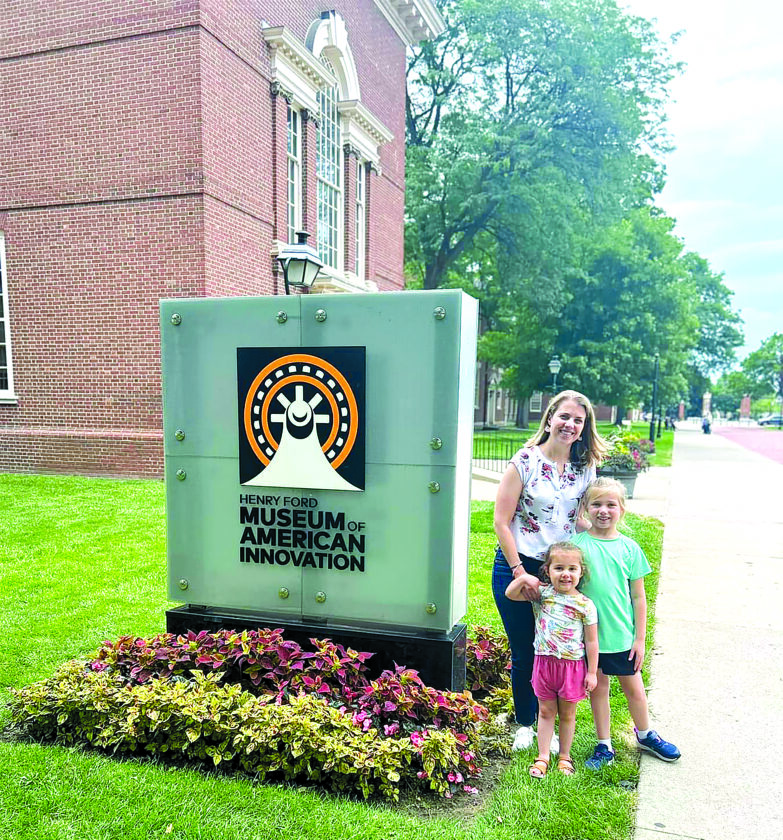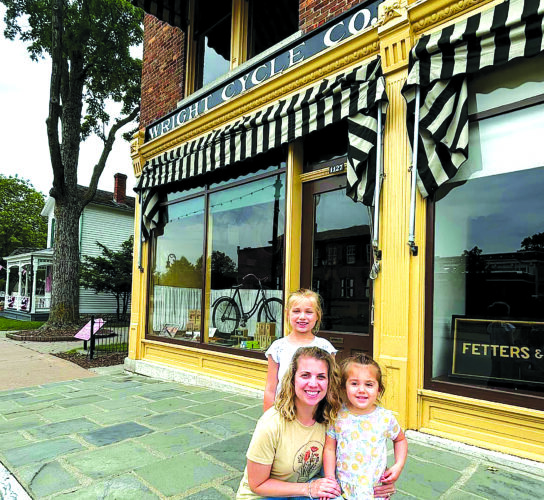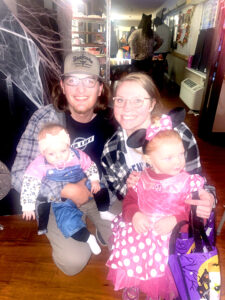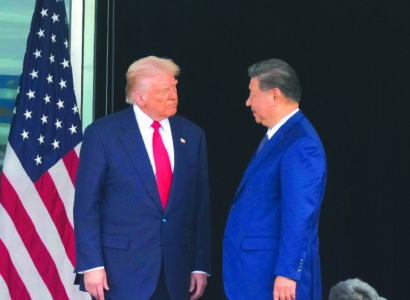Book inspired by Ford Museum experience
Mifflin County native participated in Educator in Residence program

Submitted photo
Emily Book, a Mifflin County native and teacher in the Greenwood School District, stands with her daughters, Amelia, 7, and Nora, 3, outside the Henry Ford Museum of American Innovation.
PORT ROYAL — Emily Book’s idea turned into history.
From an early age, the Mifflin County native loved to read about magical places that seemed destined for her only to see on the pages of text or reference books.
Being selected to participate in the prestigious Educator in Residence program this summer at the Henry Ford Museum of American Innovation, located in Dearborn, Mich., not only changed the Greenwood School District teacher’s perspective on America’s great inventors and innovators but has altered her approach to teaching in her classroom.
Educators attending the program got to experience the Ford Museum as well as the adjoining Greenfield Village. The 200-acre property consists of a collection of nearly 100 historic homes and buildings — many relocated or reconstructed from all over the country.
For example, there was the Wright Brothers’ family home and Wright Cycle Co., Thomas Edison’s laboratory, Noah Webster’s home and the Heinz family home. Additionally, the village had a steam-powered railroad, Firestone family farmhouse and barn and original Ford Model Ts for the educators to ride in.

Submitted photo
Mifflin County native and Greenwood School District teacher Emily Book stands with her daughters, Amelia, 7, and Nora, 3, next to the Wright Cycle Co. in Greenfield Village.
“This has been, to date, the most inspiring experience I have had in my professional career as a teacher,” Book said. “Prior to attending the program, I never thought to include a unit on agriculture within the elementary STEM (science, technology, engineering and math) curriculum.”
Book learned about the program last year while searching for innovative activities that she would share with her students as well as other teachers in her role as a technology innovation coach.
“During my search I happened to come upon the inHub by the Henry Ford website,” Book recalled. “The phrase, ‘A Global Resource for Activating an Innovative Mindset’ really caught my attention.
“As I began digging into the many resources inHub has to offer, I soon realized there was an opportunity to apply for the Educators in Residence program,” she added.
With her love of history at the forefront of her mind, Book didn’t have to think twice about applying. She never imagined that her application would be selected.
“I have always loved learned about history and sharing innovative activities with my students, so after reading that I could potentially be chosen to go explore over 26,000 artifacts and collaborate with educators from across the United States, I was very eager to apply,” said Book, who lives in Port Royal and is currently working in the Greenwood School District as the new elementary STEM teacher.
“I also knew STEM was a great passion of mine as I had been researching and implementing STEM-based activities and projects in my classroom for the last several years,” she added. “In doing this, I saw an increase in motivation, creativity and enthusiasm for learning in my students.”
Attending the program provided Book with new insight into innovation and the challenges many of the country’s great inventors and innovators had to overcome.
“One of my favorite takeaways was an activity we did as a group where we went back in time and explored the life of a particular inventor or innovator,” she explained. “We placed ourselves in the inventors’ shoes and answered questions about how the individual would have felt about his or her challenges, difficulties that were faced during a particular time period and how he or she persevered.
“This is a great way to teach students how to be empathetic and understand the needs of others,” she added. “Social emotional learning is an essential part of STEM education. Students use these skills to communicate, collaborate, problem-solve and express their creativity during various team challenges and projects.”
Book feels very fortunate to have been selected for the program as there were only 14 educators invited – seven from Michigan and others from Maine, Idaho, Indiana, West Virginia, Ohio and Pennsylvania.
“STEM education can spark curiosity and passion in students, teaching them how to pursue their interests and set goals,” Book said. “This can contribute to a sense of purpose and emotional well-being. It is imperative we give our students hands-on opportunities to explore their creativity, which will lead students to becoming successful problem-solvers and critical thinkers as they go throughout their educational journey and beyond.”
Even though the program ended, Book and her cohorts are continuing to work on projects they created this past summer. They hold follow-up sessions via Zoom where they discuss how to implement their projects. “This also gives me ongoing opportunities to collaborate with the education development team at the Henry Ford and the other educators I met,” Book added.
Book has incorporated the “habits” of an innovator into her teaching this fall. “The habits of an innovator are part of the Model I Framework and are a frame of mind,” she explained.
The habits include:
Challenge the rules – Turn can’t into can do, dare to be different
Take risks–Think big, embrace uncertainty
Be empathetic – Walk in other people’s shoes to understand their needs
Collaborate – Share what you know, respect what others bring
Stay curious – Learn something new and ask questions
Learn from failure – Be resilient, use feedback to make improvements
Prior to coming to Greenwood, Book taught in the Susquenita School District for 14 years.
As an added perk, Book was able to bring her husband, Gabe, and daughters, Amelia, 7, and Nora, 3, with her to the program.
“In the last few months since attending the program, I have done my own research to learn more about certain areas involving agriculture which include mechanization (the invention and widespread adoption of farm machinery, such as the plow, tractor and combine harvester), agricultural robotics, and vertical farming and hydroponics,” Book said.
“My goal over the next few months is to add a vertical garden to the STEM classroom,” she added. “The vertical garden would enhance STEM literacy by providing students with real-world applications of science, technology and math concepts. It would also deepen their understanding of plant biology, ecology, and environmental science.”
Book is also currently working on developing agriculture units for her students, which she hopes to roll out in the spring.



